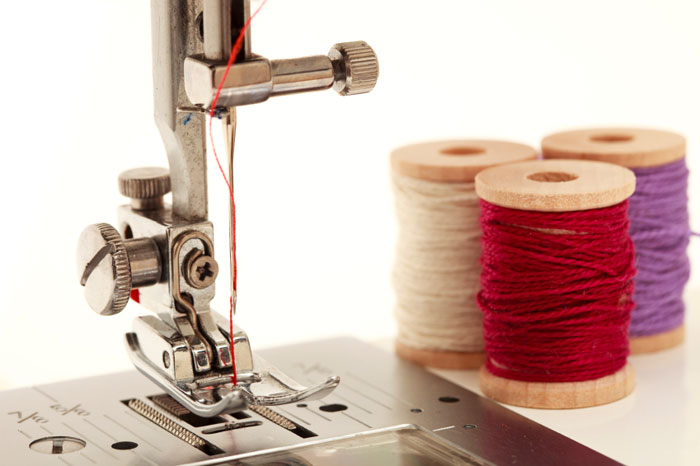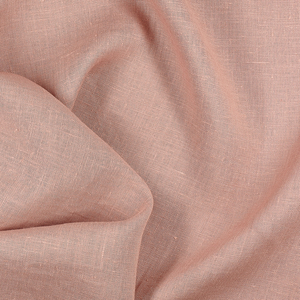Sewing Tips: Pull It Together!
Gathering is an essential part of many fabulous sewing projects. Want to add some sophistication to those standard curtains? A bit of ruffling may do the trick. Gathered fabric can transform a few yards of linen fabric into a beautiful tiered skirt.
My favorite projects usually start as skirts and dresses, so there are often several yards of fabric that needs to be gathered before my project even begins! I’ve spent many hours researching the best ways to gather fabric, and here are a few of the best methods I’ve found.
Single stitch gathering:
Sew a long baste stitch with the lowest tension settings on the fabric you want to gather.
Tip: It’s best to sew your gathering stitch approx. 1/8″ less than your seam allowance, so that you’re not sewing the baste stitch below your seam allowance. If you sew your gathering stitch below the seam allowance, then your gathering stitch will be visible when you turn the fabric right side out.
Begin gathering the fabric by pulling on the bottom thread, and sliding your fabric across it, pulling the thread tighter and gathering the fabric. Pin to your fabric as you go, and use a regular straight stitch to secure the gathered fabric. Turn right side out to see how lovely your project looks! (Don’t forget to iron and topstitch if your project calls for it!)
There are positives and negatives to using single stitch gathering. It’s very quick and easy to do, and works well with smaller projects or pieces of fabric. However, the gathering is imprecise, and might look messy on larger projects due to the gathered fabric slipping in the sewing machine.
Dual Stitch Gathering:
Sew two long baste stitches with the lowest tension settings, with each stitch ‘¼” to ‘½” apart.
When you gather the fabric, use the bottom thread on each line of stitching to pull the fabric together. Go slowly and gather both threads in an equal amount in order to keep the gathering even.
While this gathering technique is a very slow process, you will get the most precise results possible.’ Pin to your fabric as you go, and put your securing straight stitch in-between the two gathering baste stitches. This allows you to have a perfect, evenly gathered fabric with nice, straight stitching.
To get rid of the gathering stitch that shows on the right side, keep pulling on the thread you used to gather the fabric. It will feed completely through the fabric! You can shake out the fabric a bit and the holes from the stitch should be gone. (Silk or satin can be very delicate, so this may not be the best technique to use on those fabrics.)
Gathering with a serger:
Did you know that it’s possible to gather fabric using a serger? I gather so much fabric during my sewing adventures (I just love lace and skirts, okay?) that I invested in a serger solely to help cut down on the amount of hand-gathering that I had to do.
To gather using a serger, set your Differential Feed (the speed at which your serger pulls the fabric through using the feed dogs) to the highest setting, and your stitch length to the longest setting.
For lightweight, non-stretch fabrics, this alone will be enough to begin gathering the fabric. Perfect for lightly gathered ruffles. If you want the gathering to be tighter, the next step is to pull the two straight-stitch threads out of the chain, and use them to gather the fabric together like in the dual stitch gathering process.
This is my favorite method to use when I’m in a hurry, or for smaller projects such as doll clothes.
Gathering With Feet:
Not with those silly things on the ends of your legs, but with feet for your machines. There are a few different kinds of gathering feet available that can be used on most sewing machines.
The most common gathering foot is a small foot with a little ridge underneath it, which pulls the fabric together as you sew (click here for an example of this foot). It works well with very lightweight fabric and can work for midweight fabrics – but for most others it forms a very loose gather.
There’s another version of the small gathering foot that includes a slot on the bottom to feed a second length of fabric into the foot (click here for an example of this foot). This allows to you immediately sew the gathering fabric to the un-gathered fabric in one step.
There’s also the scary looking ruffling foot with a heart of gold (click here for an example of this foot). This foot does an amazing job at gathering fabrics, though it is mainly useful for its namesake: ruffles and pleats. ‘ While you sew with this foot, the foot shoves the fabric underneath your needle. You can adjust parts of the sewing foot to create thinner or wider pleats, and adjust when the pleats are made (every 12 stitches, every 6 stitches, every stitch, etc.).
Tips for gathering:
- Mark on the fabric that will be gathered where the center and quarter points are, and mark the same points on the fabric that the gathered fabric will be sewn to. This will allow you to match the marks and have an evenly gathered piece all the way around your project.
- Secure one end of the thread by tying a knot before you start gathering, to keep the thread from being pulled completely through the fabric.
- Work in sections to help keep the gathering even. When I have to gather fabric, I start in the center and work to the ends.
What’s your favorite way to gather fabric? Share your tips in the comments!














































11 Comments
Judith Bengochea
Thank you for the great tips. I have been making some historical costumes and the heavy fabric has created some gathering challenges for me. I think you have put me on the right path. I will try several of your “tips”.
Susan H
Another method is to use your sewing machine with a wide zigzag stitch in the seam allowance, and then use a heavier weight of thread or dental floss as the gathering thread. Feed this thread on top of your fabric right under the center mark on your multi-purpose presser foot. I find it helpful to knot the far end (the end on the back side of the presser foot) of the heavy thread first, so it won’t slip out of the channel created by the two sides of the zigzag stitch.
When finished stitching, use the heavy thread to pull up the fabric to create the fullness you’re looking for. Then stitch a line of straight stitching in the seam allowance just outside the zigzags to secure the gathers.
Vikki A
Purchase waxed dental floss, no color or flavoring, good quality. Must be waxed and colored will stain light colors.
Pull a good length from package but don’t cut. Set sewing machine for largest zig-zag stitch.
Line up floss to end of thread tail, zig-zag over floss so all stitching will be inside seam allowance.Leave tail of floss at the end.
Now you should be able to pull gathers evenly, as it should just slide into place.
I’ve used this method for many pillows, dust ruffles and skirts.
Janet Thomasson
I use dental floss to gather! I run a zig-zag stich over dental floss (making sure to NOT catch the dental floss with the needle), then pull up the dental floss to make the gathers. The dental floss is much stronger than thread, so it won’t break and cause you to loose all those gathers you’ve just made.
Jannet Hendrickson
My favorite way to gather is pull the bobbin thread up through the fabric, set machine to a small zigzag stitch, pull both bobbin and top thread to a long enough length to cover length of fabric to be gathered. Zigzag over these pulled threads …. it’s anchored on the one end where you started zigzagging and you don’t break the threads while pulling them to gather. It is so simple to do it this way and no frustration of the gather thread breaking half way through the gathering.
Joanne
I think on of my favorite and most successful ways to gather is using a long, large zigzag stitch over a light weight cording such as a crochet cotton or a heavy duty thread. I have an embroidery foot for my machine that has a hole to put the cord/heavy thread through so that it stays in the center while the zigzag is sown over it which makes it easy. The end result thought is something very sturdy to pull. When I am working on a heavier weight or long piece of fabric to gather this is my go to technique for sure!
Ann D.
Another way is to cut a piece of 1/4″ elastic to a length a little shorter than you want the finished piece to be (a bit shorter because it does stretch out a bit). Pin your fabric and the elastic together (I usually divide each into quarters and match the quarter marks). Then stretch the elastic and sew it down to the fabric–instant gathers!
Michaela Smith
Hi Ann, this is a sewing technique called “shirring”, when it’s used in the garment to allow for a bit of give in the fitting (like on the back of a dress or in the sleeves). It’s a great technique and certainly does provide instant gathers! 🙂 I love using this method to make fitted sleeves (really cute for medieval/renaissance inspired styles too).
Lyric
Uwww, I like this suggestion, Ann D. I need to print and put in my sewing notes. 😉
Mary
You missed my favorite way of gathering: Sew a wide, long zigzag stitch over a heavy thread, taking care not to catch this thread. Then pull on the heavy thread to gather the fabric. After the fabric is sewn down, remove the heavy thread.
Michaela Smith
Mary, you’re right! I haven’t used this method myself. The task of removing the zigzag stitching seems very daunting. Do you stitch just below the zigzag to avoid having to remove the threads?